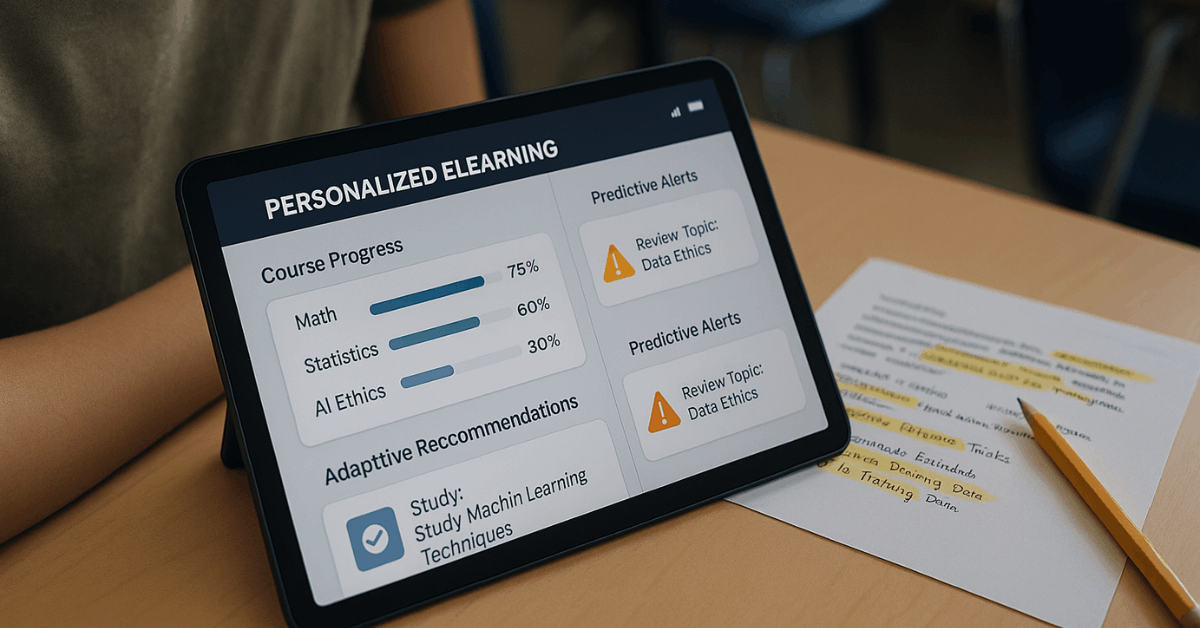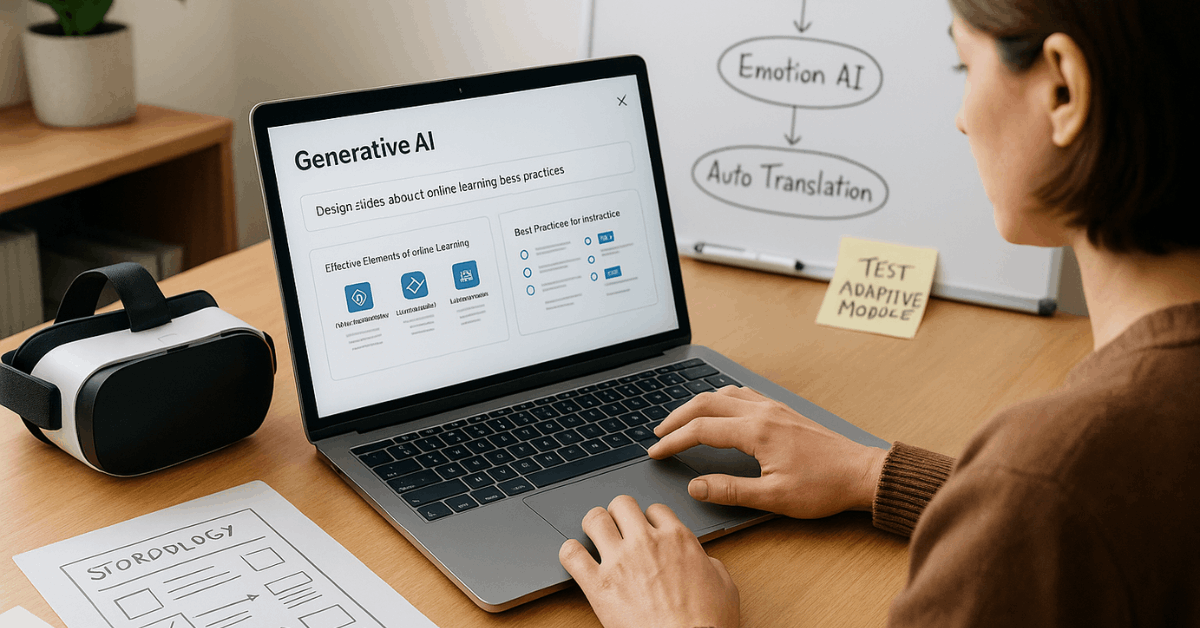Artificial intelligence is shaking up digital education worldwide, changing how courses are designed, delivered, and improved in real time.
This guide shows you exactly where AI fits into modern eLearning, why it matters for your organization, and how to stay ahead of the curve.
What is AI in eLearning?
AI in eLearning refers to algorithms and machine-learning models that personalize study paths, automate routine tasks, and supply data-driven insights for faster progress.

Tailored Delivery
AI systems can analyze a learner’s pace, behavior, and preferred format, then adapt course content accordingly.
This means students get the right level of challenge—neither too easy nor overwhelming—which keeps them engaged and improves comprehension.
Automated Support
Virtual assistants like chatbots and voice interfaces handle repetitive questions, grade assignments, and offer instant feedback.
That frees up instructors to focus on more meaningful mentorship and support, especially when learners hit roadblocks.
Real-Time Analytics
AI-powered dashboards surface issues before they snowball. If a learner is falling behind, the system can flag it early, helping instructors step in with support, adjustments, or alternative materials that better match the learner’s needs.
Defining the Role of AI in Digital Education
AI already commands a multibillion-dollar global market, bridging gaps traditional classrooms leave open and driving fresh teaching strategies.
Core Functions:
- Adaptive engines pinpoint ideal content sequencing.
- Natural-language processing (NLP) enables conversational help desks.
- Predictive models flag performance risks long before dropout.
Artificial Intelligence in eLearning Market Overview
Rapid adoption is no longer optional—research predicts worldwide AI-in-education revenues will soar past USD 30 billion before 2032.
Market Indicators
| Metric | 2024 Value | 2030-2032 Projection |
| Global eLearning spend | USD 400 billion + | USD 848 billion + |
| AI share in education | USD 5 billion + | USD 30-48 billion |
How AI Is Reshaping Personalized Learning
Personalization drives retention and mastery when each learner receives content that matches exact needs.
Adaptive Learning Paths
An engine tracks speed, accuracy, and preferred formats, then reshuffles lessons or repeats topics until mastery shows in data logs.
Intelligent Tutoring Systems (ITS)
AI tutors answer follow-up questions instantly, provide detailed feedback, and recommend extension tasks that target weak spots.
Making Learning More Accessible
Real-time translation, speech-to-text captions, and screen-reader prompts make high-quality material reachable for worldwide audiences.
The Impact of Predictive Analytics in eLearning
Predictive engines convert raw activity logs into clear action points that raise pass rates and cut attrition.
Data-Driven Course Adjustments
Heat-maps reveal where learners stall, prompting instructors to rework examples or add scaffolded exercises.
Identifying At-Risk Students
Alerts trigger when engagement drops, allowing timely outreach through mentors, SMS nudges, or micro-assignments.
The Benefits of AI in Content Creation
Course building often drains faculty hours; AI speeds production while keeping material fresh.
Automating Course Materials
Prompt-based generators produce quizzes, case studies, and slide decks that align with standards or certifications.
Easing the Burden of Grading
Formative assessments, essays, and code challenges receive instant scores plus targeted comments, freeing educators for higher-value mentorship.
Improving Engagement with Interactive Content
Scenario builders, branching stories, and micro-simulations keep attention high and embed skills through practice.

The Challenges of AI in eLearning
New technology introduces risks that demand proactive controls.
Data Privacy and Security
Sensitive learner records require encryption, clear consent notices, and region-specific compliance audits.
AI’s Role in Bias and Accuracy
Training data reflecting historical imbalances can reinforce stereotypes unless diverse datasets and human review checkpoints are in place.
Copyright Issues
Using public content for model training raises ownership questions that policy frameworks must address.
Challenge-Solution Table:
| Common Concern | Practical AI Safeguard |
| Personal data leaks | End-to-end encryption; regional data centers |
| Algorithmic bias | Diverse datasets; recurring fairness audits |
| Misinformation | Human SME review before release |
| Uncredited source use | Digital-rights management plus attribution tools |
Future Trends in AI-Driven eLearning
Emerging technologies promise deeper immersion and motivation.
The Integration of AI and Virtual Reality (VR)
Immersive simulations let you “walk” through historical events or engineering blueprints, with AI adapting scenes to prior knowledge.
AI-Driven Gamification in eLearning
Systems assign real-time challenges, update leaderboards, and adjust difficulty on the fly, turning lessons into rewarding quests.
Preparing for the Future of AI in eLearning
Staying agile means pairing machine precision with human warmth.
Staying Ahead of AI Trends in Education
Invest in flexible platforms that integrate new plugins easily and deliver multilingual support automatically.
TalentDesk’s E-Learning Insights Report 2024
Freelancers already comprise roughly one-third of many international teams, driving demand for modular, AI-friendly upskilling paths.
Best AI Tools for eLearning
These platforms combine speed, scalability, and user-centric design.
- WorkRamp – All-in-one Learning Cloud with AI Assist authoring.
- Adobe Captivate – Multimedia powerhouse with ChatGPT integration.
- Docebo – Cloud LMS featuring generative AI search and coaching.
- Lectora – Advanced authoring with AI Course Wizard for rapid drafts.
- iSpring – PowerPoint-based suite delivering interactive quizzes fast.
- Elucidat – Collaborative creator with accessibility-first templates.
The Ways AI Is Transforming eLearning
Several AI-enabled methods reshape classrooms worldwide.
Computer-Assisted Instruction (CAI)
Programs adjust content sequencing according to speed and accuracy metrics.
Virtual Assistants
Chatbots answer FAQs instantly and send deadline reminders.
Intelligent Agents & Intelligent Tutoring Systems
Agents analyze free-text responses, then guide you toward corrective resources.
Educational Data Mining
Patterns in clickstreams reveal which instructional methods yield higher retention.
Gamification & Automated Assessment
Adaptive games and auto-scored quizzes keep motivation high without exhausting instructors.
Conversational Interfaces & Cognitive Computing
Natural-language queries unlock resources quickly, while cognitive engines provide context-aware guidance.
Benefits of Using AI in eLearning
AI does more than save time; it elevates learning quality.
- Adaptive sequencing increases concept mastery rates.
- Real-time chat lowers frustration, boosting course completion worldwide.
- Automated translation extends reach to non-native speakers without cost spikes.
- Analytics help executives link training investment to performance gains/
Advantages of AI for Corporate Training
Organizations see measurable returns when AI supports workforce development.
- Automated upskilling: Gap analysis maps new skills to growth roles automatically.
- Engagement uplift: Gamified dashboards keep remote employees motivated.
- Competitive edge: Faster rollout of compliance or product courses accelerates global launches.
Concerns of AI in eLearning
Responsible adoption depends on addressing three big worries.
AI Algorithms Can Be Biased
Ongoing audits plus diverse testing groups minimize skewed outcomes.
AI to Replace Humans
Human mentors remain essential for empathy, mentorship, and cultural nuance.
Data Privacy and Security
Strict role-based permissions and transparent logs build learner trust.
How to Deal With Concerns About Using AI in eLearning
Adopt a layered mitigation approach.
- Create ethical checklists spanning data provenance and consent.
- Combine human review cycles with automated testing.
- Publish clear user policies regarding model limitations.
- Encourage feedback loops to refine both content and algorithms.
AI in eLearning: Obstacles to Overcome
Hiring AI talent, funding infrastructure, and proving ROI often slow deployments, yet outsourcing or phased rollouts can lower barriers.
Obstacle Breakdown:
- Talent shortages: Partner with specialized vendors or freelancers.
- Low data literacy: Run internal workshops on analytics basics.
- Budget doubts: Start with a minimum viable product, then scale features after pilot success.
Do You Need Artificial Intelligence to Meet Your eLearning Needs?
Organizations that adopt AI today position themselves for sustainable growth.
Fast-Track Checklist:
- Define measurable learning outcomes.
- Select modular AI tools compatible with current systems.
- Budget for continuous SME oversight.
- Pilot, evaluate, and iterate before full rollout.
Bottom Line
AI already powers a smarter, more inclusive, and intensely data-driven learning ecosystem worldwide.
Committing to ethical, human-guided implementation lets you unlock adaptive paths, instant assessment, and global reach—without sacrificing empathy or academic integrity.
Start small, measure relentlessly, and refine each cycle; success follows when technology and human insight advance together.










